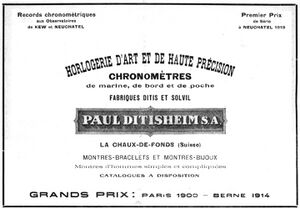Solvil et Titus
Solvil, Titus, and Didis are brands created by watchmaker and entrepreneur Paul Ditisheim, whose family had founded the Vulcain brand. The company was later widely known as Solvil et Titus and continues in operation within Ebel and Stelux today.
Paul Ditisheim

- See Also: Paul Ditisheim
Paul Ditisheim was part of the well-known Ditisheim family of watchmakers of Switzerland. He studied watching in La Chaux-de-Fonds and worked at his family's factory, known for the Vulcain brand, starting in 1887.
Ditisheim founded his own company in 1892 and was located at 11 Rue de la Paix in La Chaux-de-Fonds by 1894. His initial products included watches and jewelry with cylinder and anchor escapements as small as 7 ligne. Ditisheim advertised that he produced watches in both the English (bridge) and Glashütte (three quarter plate) style, including chronometers. The company specialized at that time in compact movements, including ladies chronometers with enamel and jewelry.
Paul Ditisheim was already drawing recognition for this chronometers before the turn of the century. He took 1st class in the 1895 competition at Neuchâtel and won a gold medal at the 1896 Exposition Nationale de Geneva. This earned him a place on the jury at the International Exposition in Brussels in 1897. His chronometers continued to win prizes at Neuchâtel in 1897 and 1898 and the grand prize at the Universal Exposition in Paris in [[1900].
Ditisheim's products were marketed for their accuracy and anti-magnetism, with his watches recognized in observatory chronometer contests by 1903. Ditisheim set a new chronometry record at Royal Key Observatory in 1912, and he worked closely with Nobel Prize-winning physicist Charles-Edouard Guillaume to improve accuracy of his watches. Paul Ditisheim also collaborated with chemical engineer Paul Woog at this time, and the company produced well-known lubricants and oils with his name in the 1920s.
By 1902, Ditisheim was producing deck clocks, and was supplying these to the United States Navy by 1908. The company had also branched out into emerging categories: Ultra-thin pocket watches and "bracelets-montres" by that year. Ditisheim had also begun to use the Ditis brand on watches by 1908. Ditisheim was producing men's wristwatches as well by 1918.
Needing more space, Ditisheim hired architect Henri Grieshaber to build a modern new workshop at Rue Serre 24, adjacent to the 1869 building already used at Rue du Parc 25. This building had large windows and is just six meters wide, providing optimal working space for the occupants. It features a large sign reading "Chronometres" which is still visible today.
Solvil et Titus
Watchmaker Paul-Emile Chopard specialized in shaped watch movements, registering designs resembling hearts and shields. Paul Ditisheim produced similar shaped watches in the 1890s and it is likely that he worked with Chopard to develop the movements. Ditisheim himself was interested in producing smaller shaped watch movement for ladies and novelty watches, though the majority of his work in La Chaux-de-Fonds was on large pocket chronometers.
The pair sought to bring the watchmaking industry to Chopard's home village of Sonvilier in the Vallon de Saint-Imier following World War I. Paul-Emile Chopard created a firm called Chopard et Houriet with Louis Houriet on January 1, 1918, and this lasted through 1925 and seems to have been focused on small oval movements based on Chopard's patents. More importantly, Chopard incorporated a Société Anonye called Fabrique La Suze SA in March of 1918. This company was to establish a new watchmaking factory on the banks of the river Suze, which runs through the valley.
Paul Ditisheim registered a new brand reflecting the name of the town, Solvil, in April 1918, suggesting he was working with Chopard on this effort. Thus, Fabrique La Suze was renamed Fabrique Solvil à Sonvilier on August 15, 1918. Share capital was increased from 20,000 to 100,000 francs at this time, suggesting that Ditisheim poured his personal wealth into the effort.
Over time, the Solvil brand would displace Ditisheim's own as well as the shortened Ditis and would become the name of the entire company.
Paul Ditisheim SA (the original La Chaux-de-Fonds firm) declared bankruptcy in June 1929, though Fabrique Solvil des Montres Paul Ditisheim SA of Sonvilier was not affected. Just a month later Solvil relocated its headquarters to La Chaux-de-Fonds, effectively re-starting the company anew. Thus, the firm was able to clear the debts of the old company and continue operation.
The Titus brand would appear by 1934 at Parc 25 under the name "Titus SA". Though the larger company was still called Paul Ditisheim SA, the watches were now sold as Ditis, Solvil, and Titus, the latter two incorporated separately as Solvil SA and Titus SA in Sonvilier and La Chaux-de-Fonds, respectively.
Paul-Bernard Vogel
The company was purchased by Swiss businessman Paul-Bernard Vogel in 1930, who moved the company to Geneva. But the name Paul Ditisheim would remain associated with the company and used in advertising for decades after.
The company continued offering watches under three brands: Solvil was a high-end brand continuing Ditisheim's legacy, Ditis was the modern chronometry brand, and Titus was an anti-magnetic watch at a moderate price.
Solvil et Titus was a founding member of Societe des Gardes-Temps, a group of lower-cost watchmakers, starting in 1968. This also included the American Waltham and (after 1973) Elgin companies.
In the 1970s, Paul-Bernard's son Paul Vogel took over and focused on the Asian market. He sold the European operations to Ebel and integrated the Hong Kong company with Stelux in 1977.